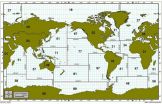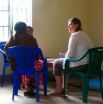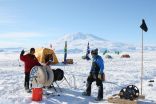(Press-News.org) The most comprehensive assessment conducted by the Ocean Health Index rates the Earth's oceans at 67 out of 100 in overall health. In addition, for the first time, the report assessed the Antarctic and the 15 ocean regions beyond national jurisdiction (high-seas areas) — all critical regions for maintaining a healthy climate, safeguarding biodiversity and providing sustainable food sources.
In the third annual update of the index, a partnership led by scientists from UC Santa Barbara's National Center for Ecological Analysis and Synthesis (NCEAS) and Conservation International (CI), the Antarctic and the Southern Ocean region scored 72, while the average score of the high seas was 67 out of 100. These distant areas had not been included in earlier assessments because they required additional data.
Together with the 220 exclusive economic zones (EEZs) measured in 2012 and 2013, the index now measures all of the oceans on planet Earth. The overall score for global EEZ, accounting for modification and updates of data and methods, was 67 in the first two years and 68 in 2014. These EEZs along with the inclusion of the high seas and Antarctica and the Southern Ocean assessments begin to provide a more complete picture of ocean health, even though most of those areas are not yet adequately studied.
"During our first two years, we were able to show the health of the oceans within 200 nautical miles of coastlines, but it was like doing a jigsaw puzzle where you put the edges together first," said Ben Halpern, professor at UCSB's Bren School of Environmental Science and Management and an NCEAS associate. "Filling in the rest of the puzzle with Antarctica and the high seas completes the picture and is a major step toward better understanding the state of our entire oceans."
For the Antarctic and Southern Ocean the eight goals assessed were Food Production (55), Natural Products (29), Coastal Protection (99), Economies and Livelihoods (83), Tourism and Recreation (55), Sense of Place (46), Coastal Protection (99), Clean Water (100) and Biodiversity (94).
"The Antarctic's biodiversity score of 94 out of 100 is encouraging, but it is based on data from only 132 species that have been formally assessed," said Catherine Longo, project scientist at NCEAS and lead scientist of the Antarctica assessment.
"Antarctica and the Southern Ocean are protected by distance from many of the threats caused by human populations, such as chemicals, excessive nutrients, and pathogens and trash," noted Greg Stone, chief scientist and executive vice president of the Moore Center for Science and Oceans at Conservation International. "That's why we see a very high score in a goal like Clean Water."
"The score of 100 that is set as a target for each goal reflects a status that is feasible to achieve and can sustainably produce maximum benefits now and in the future," added Steve Katona, managing director for the Ocean Health Index. "Any score below 100 means there is room for improvement."
The high seas assessment included three goals and subgoals: Fisheries, Iconic Species and Biodiversity (measured as the threat of extinction to all assessed species). "The high seas are home to important fisheries for species such as tuna and provide habitat or migratory pathways for iconic species such as whales, sharks and sea turtles," said Elizabeth Selig, conservation scientist with CI and the lead scientist on the high-seas assessment. "Like the Antarctic assessment, the vast size and remoteness of the high seas has limited our ability to study all of the habitats and organisms present, so the biodiversity scores for these regions were based only on species whose populations have been formally assessed."
The Western Indian Ocean and Eastern Central Atlantic Ocean scored highest overall at 79 and the Northwestern Pacific Ocean scored lowest at 53. The Eastern Central Atlantic Ocean had a Fisheries score of 81 out of 100, followed by the Western Indian Ocean with 80, making them the highest-scoring sectors for fisheries. At 7, the Northwestern Pacific Ocean had the lowest Fisheries score because, among other things, its stocks were farthest from the biomass that provides maximum sustainable yield.
In addition to this third global update of the Ocean Health Index, two regional assessments were issued this year: one that evaluated ocean health of Brazil's 17 coastal states and a second measuring the health of the United States West Coast. The next global assessment is planned for September 2015.
INFORMATION:
Rating the planet's oceans
Researchers from UCSB's National Center for Ecological Analysis and Synthesis helped produce the first Ocean Health Index that includes all the Earth's oceans
2014-09-30
ELSE PRESS RELEASES FROM THIS DATE:
New diagnostic approach for autism in Tanzania
2014-09-30
PROVIDENCE, R.I. [Brown University] — Autism is no stranger to the children of Tanzania. What is rare in the East African nation is access to clinical services, including reliable diagnosis and evidence-based treatments. There is no autism diagnostic measure, for example, validated for use in Swahili, a major language of the region. In a small new study, however, researchers at Brown University and the University of Georgia (UGA) describe a culturally compatible diagnostic approach that they implemented at two sites in the country and found to be effective for making diagnoses.
The ...
This week from AGU: Measuring Antarctic ice loss, Indian Ocean program, Oregon landslides
2014-09-30
This week from AGU: Measuring Antarctic ice loss, Indian Ocean program, Oregon landslides
From AGU's blogs: Scientists use fiber-optic cables to measure ice loss in Antarctic
Researchers installed moorings containing fiber-optic cables hundreds of meters down into the McMurdo Ice Shelf in West Antarctica to collect temperature information about the base of the ice shelf, where the thick platform of floating ice meets the ocean. The sensors were able to measure mere millimeters of ice loss at the interface, demonstrating that the new fiber-optic method could be ...
Depression increasing across the country
2014-09-30
SAN DIEGO, Calif. (Sept. 30, 2014)— A study by San Diego State University psychology professor Jean M. Twenge shows Americans are more depressed now than they have been in decades.
Analyzing data from 6.9 million adolescents and adults from all over the country, Twenge found that Americans now report more psychosomatic symptoms of depression, such as trouble sleeping and trouble concentrating, than their counterparts in the 1980s.
"Previous studies found that more people have been treated for depression in recent years, but that could be due to more awareness and less ...
Disease decoded: Gene mutation may lead to development of new cancer drugs
2014-09-30
ANN ARBOR—The discovery of a gene mutation that causes a rare premature aging disease could lead to the development of drugs that block the rapid, unstoppable cell division that makes cancer so deadly.
Scientists at the University of Michigan and the U-M Health System recently discovered a protein mutation that causes the devastating disease dyskeratosis congenita, in which precious hematopoietic stem cells can't regenerate and make new blood. People with DC age prematurely and are prone to cancer and bone marrow failure.
But the study findings reach far beyond the ...
New guidelines for treatment of hypothyroidism endorse current therapy
2014-09-30
WASHINGTON (Sept. 30, 2014) — Levothyroxine is considered the gold standard therapy for an underactive thyroid gland (hypothyroidism), and a new review of therapies for the condition — including combining levothyroxine with another agent — has not altered that assessment, say a team of investigators.
1Their analysis, published as a set of guidelines in the journal Thyroid, finds insufficient consistent data exist to recommend a change in use of levothyroxine — whether generic, or sold under various trade names, such as Synthroid® — as the only drug needed to treat hypothyroidism.
"Levothyroxine ...
A new dimension for integrated circuits: 3-D nanomagnetic logic
2014-09-30
This news release is available in German.
Electrical engineers at the Technische Universität München (TUM) have demonstrated a new kind of building block for digital integrated circuits. Their experiments show that future computer chips could be based on three-dimensional arrangements of nanometer-scale magnets instead of transistors. As the main enabling technology of the semiconductor industry – CMOS fabrication of silicon chips – approaches fundamental limits, the TUM researchers and collaborators at the University of Notre Dame are exploring "magnetic computing" ...
Medicaid and Uninsured patients obtain new patient appointments most easily at FQHCs
2014-09-30
PHILADELPHIA – Federally Qualified Health Centers (FQHCs) granted new patient appointments to Medicaid beneficiaries and uninsured patients at higher rates than other primary care practices (non-FQHCs), in addition to charging less for visits, according to results of a new 10-state University of Pennsylvania study published this month in Medical Care.
Using data from a previous "secret shopper" study conducted in 2012 and 2013, the investigators found that FQHCs — community health clinics that receive federal funding to provide primary care access to underserved populations ...
UCI study uncovers important process for immune system development
2014-09-30
Irvine, Calif., Sept. 30, 2014 — Research by UC Irvine immunologists reveals new information about how our immune system functions, shedding light on a vital process that determines how the body's ability to fight infection develops.
In the online version of Nature Immunology, neurology professor Dr. Michael Demetriou, postdoctoral scholar Raymond Zhou and other Institute for Immunology colleagues describe a critical mechanism underlying how T cells are created, selected and released into the bloodstream.
A T cell is a type of blood cell called a lymphocyte that protects ...
Expect 6,000 more Australian deaths if pollution rises to 'safe' threshold
2014-09-30
The National Environment Protection Measures (NEPM) has set maximum daily limits, or 'standards', for six key outdoor pollutants, which QUT's Associate Professor Adrian Barnett says many authorities wrongly assume to be 'safe' thresholds for health.
To test that assumption, Professor Barnett calculated what the health effects would be if the current average levels of five of those pollutants across Melbourne, Sydney and Brisbane were to rise to just below the NEPM 'safe' standards.
"I've found that increasing pollution levels to just below the NEPM standards would cause ...
How to predict who will suffer the most from stress
2014-09-30
Montreal, September 30, 2014 — More than 23 per cent of Canadians report being stressed or very stressed on most days. While chronic stress increases the risk of poor mental and physical health, not everyone is affected the same way. Some cope well, but for others — especially those most likely to sweat the small stuff — chronic stress can be harmful.
Thankfully, new research from Concordia University has found a way to identify those most susceptible to stress. That's a huge help for healthcare professionals working to stop stress before it gets out of control.
The ...
LAST 30 PRESS RELEASES:
Azacitidine–venetoclax combination outperforms standard care in acute myeloid leukemia patients eligible for intensive chemotherapy
Adding epcoritamab to standard second-line therapy improves follicular lymphoma outcomes
New findings support a chemo-free approach for treating Ph+ ALL
Non-covalent btki pirtobrutinib shows promise as frontline therapy for CLL/SLL
University of Cincinnati experts present research at annual hematology event
ASH 2025: Antibody therapy eradicates traces of multiple myeloma in preliminary trial
ASH 2025: AI uncovers how DNA architecture failures trigger blood cancer
ASH 2025: New study shows that patients can safely receive stem cell transplants from mismatched, unrelated donors
Protective regimen allows successful stem cell transplant even without close genetic match between donor and recipient
Continuous and fixed-duration treatments result in similar outcomes for CLL
Measurable residual disease shows strong potential as an early indicator of survival in patients with acute myeloid leukemia
Chemotherapy and radiation are comparable as pre-transplant conditioning for patients with b-acute lymphoblastic leukemia who have no measurable residual disease
Roughly one-third of families with children being treated for leukemia struggle to pay living expenses
Quality improvement project results in increased screening and treatment for iron deficiency in pregnancy
IV iron improves survival, increases hemoglobin in hospitalized patients with iron-deficiency anemia and an acute infection
Black patients with acute myeloid leukemia are younger at diagnosis and experience poorer survival outcomes than White patients
Emergency departments fall short on delivering timely treatment for sickle cell pain
Study shows no clear evidence of harm from hydroxyurea use during pregnancy
Long-term outlook is positive for most after hematopoietic cell transplant for sickle cell disease
Study offers real-world data on commercial implementation of gene therapies for sickle cell disease and beta thalassemia
Early results suggest exa-cel gene therapy works well in children
NTIDE: Disability employment holds steady after data hiatus
Social lives of viruses affect antiviral resistance
Dose of psilocybin, dash of rabies point to treatment for depression
Helping health care providers navigate social, political, and legal barriers to patient care
Barrow Neurological Institute, University of Calgary study urges “major change” to migraine treatment in Emergency Departments
Using smartphones to improve disaster search and rescue
Robust new photocatalyst paves the way for cleaner hydrogen peroxide production and greener chemical manufacturing
Ultrafast material captures toxic PFAS at record speed and capacity
Plant phenolic acids supercharge old antibiotics against multidrug resistant E. coli
[Press-News.org] Rating the planet's oceansResearchers from UCSB's National Center for Ecological Analysis and Synthesis helped produce the first Ocean Health Index that includes all the Earth's oceans




